机械类毕业论文外文翻译
- 格式:docx
- 大小:152.57 KB
- 文档页数:8
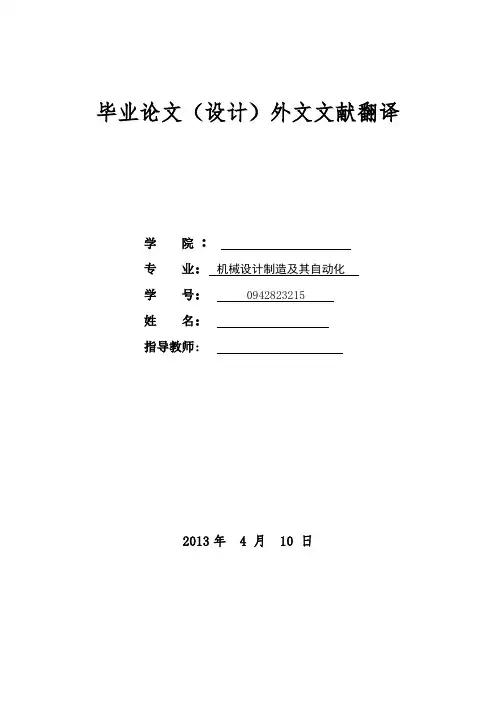
毕业论文(设计)外文文献翻译学院:专业:机械设计制造及其自动化学号:0942823215姓名:指导教师:2013年 4 月 10 日JT调度绞车Davis, C. S, S. M Ggllager, and M. S Berman设计和初步结果拱水生生物学京能集团摘要调度绞车及其结构特点调度绞车是常用来调度车辆及进行辅助牵引作业的一种绞车。
常用于矿井巷道中拖运矿车及辅助搬运,也可用在采掘工作面、装车站调度空、重载矿车。
调度绞车是一种全齿传动机械。
齿轮传动系统又称轮系。
根据轮系传动时各齿轮轴线在空间的相对位置是否固定,可分为定轴轮系和周转轮系。
定轴轮系又有外啮合圆柱齿轮传动和内啮合圆柱齿轮传动之分,而周转轮系又有差动传动和行星传动之分。
调度绞车的传动齿轮既有内啮合圆柱齿轮传动,又有行星传动,所以调度绞车又称内齿轮行星传动绞车。
调度绞车常用型号主要有JD—0.4(JD—4.5)、JD—1(JD)—11.4)、JD—1.(JD—22)、JD—2(JD—25)、JD—3(JD—40)等。
下面以JD—3(即JD—40)型调度绞车为例介绍调度绞车的组成及传动原理。
(一)JD—3型调度绞车的组成JD—3型调度绞车的主要组成部分为滚筒、制动装置机座和电动机。
绞车滚筒由铸钢制成,其主要功能是缠绕钢丝绳牵引负荷。
滚筒内和大内齿轮下装有减速齿轮。
绞车上共装有两组带式闸,即制动闸2,工作闸3。
电动机一侧的制动闸2用来制动滚筒,大内齿轮上的工作闸3用于控制Z7组运转。
机座用铸铁制成,电动机轴承支架及闸带定位板等均用螺栓固定在机座上。
电动机为专用隔爆三相笼型电动机。
(二)JD—3型调度绞车的传动原理该型绞车采用两级内啮合传动和一级行星轮传动。
Z1/Z2和Z3/Z4为两级内啮合传动,Z5、Z6、Z7组成行星传动机构。
在电动机5轴头上安装着加长套的齿轮Z1,通过内齿轮Z2、齿轮Z3和内齿轮Z4,把运动传到齿轮Z5上,齿轮Z5是行星轮系的中央轮(或称太阳轮),再带动两个行星齿轮Z6和大内齿轮Z7。

(本科毕业论文)外文文献及译文题目:Robots Make Computer Science Personal专业名称机械设计制造及其自动化学生姓名陈慧斌指导教师邓修瑾毕业时间2014.6外文文献原文:Robots Make Computer Science Personal They also make it more hands-on, real, practical, and immediate ,inspiring a newgeneration of scientists' deep interest in the field.Computer science has lost its appeal, and robots can help find it. Even as computing has in vadedevery aspect of our lives, CS as a field of study is often seen as disconnected from these same lives. So to reestablish the connection,the Institute for Personal Robots in Education (IPRE, ) is developing a personal robot, software,and curricula to help teach introductory CS courses. Imbued with the proper pedagogical philosophy and training, it can help make CS mor- epersonal.Who is to blame for the current lack of interest ? Well, me, for one. But CS education has long been a "student repellent," along with what might be viewed as asocial industry practices and unfortunate Hollywood stereotypes. Though there are islands of hope (such as Carnegie Mellon University and the Georgia Institute of Technology), overall, fewer students are enrolling in CS courses, staying with them,or moving into industry because w e have was hed them out of the classroom and the pipeline.Then again, maybe the lack of interest simply reflects the state of the U.S. economy. But if you look at the numbers over the past 20 years, at least some invariants can't be explained away by economic booms and busts. Women and minorities have always been underrepresented in computing; their numbers in the U.S.peaked almost 25 y ears ago. Meanwhile, from 1998 to 2004 the enrollment of women in CS fell 80%, from about 1.5% to about 0.25%, according to the Higher Education Research Institute at the University of California,Los Angeles (/heri/heri.html) [4]. This trend is related to CS's reputation for being impersonal to all types of students, as reflected in the falling enrollment figures across the board, also according to the Higher Education Research Institute. Foll owing recent research in CS gender issues, we no w know much mor e about the weaknesses in CS education [2], most notably that students' personal values are often at odds with the environment in CS classrooms. For example, long solitary hours in the laboratory obsessing over minute details is exactly the opposite of what many students are looking for. If CS educators would confront this reality and develop the pedagogical principles needed to fix it, w e could at least hope that the gr owing crisis in the CS pipeline might be ameliorated.Toward this end, my colleagues and I at IPRE have embarked on a multiyear project to create new introductory CS courses and textbooks designed to be accessible and inspiring to all students. The curricula are centered around a small personal robot (about the size of a paperback book) tentatively named "Gyro" being developed at the Georgia Institute of Technology (see the figure here). Our visions that each student would pur chase one for about$150 retail at their college bookstores, using them throughout their CS explorations. IPRE was initiated through a $1 million grant from Microsoft Research, announced in July 2006.At first glance, using robots may sound like a strange way to attract into CS those students who have traditionally been intimidated, excluded, or weeded-out of the field. One could imagine that robots would only exacerbate the problem rather than help alleviate it. However, CS is fundamentally about problem solving, and the example problems assigned to students in the classroom can profoundly influence ho w they perceive CS relevance and useful-ness. For example, an instructor who illustrates the topic of parsing with a com -piler example has lost an opportunity to connect CS with the rest of the everyday world. Exclusively using such incestuous examples is the equivalent of "computer science for the computer scientist." We must provide motivation that is instantly appreciated and understood by all.Having an artifact—in this case a robot—provides intrinsic motivation to both the instructor and the student to explore the science and engineering behind it. Students continue for reasons (such as fun, curiosity, and to show off to family and friends) that are very different from those traditionally identified. Consider a student who writes a program that produces the output "5" then later disco vers the correct output is "4." The instructor would likely attempt to motivate this student's innate interest in the art and science of debugging. However , the goal of producing the correct answer motivates only some students, while others see it only as a way to "please the instructor." Now consider an assignment that requires students to write a pro-gram to create a dancing robot. The notion of "correct answers" is thrown out the window. In addition, the instructor doesn't have to artificially motivate debugging because the students generate their own motivation. They initiate the debugging conversation, eager to understand and fix a program not because it is perceived by the instructor as "wrong" but because the robot doesn't do what they want it to do. Projects like "robot dancing" represent a more natural learning environment, focusing on the creative not the merely correct.Our embrace of the personal robot in the class-room is built on the shoulders of creative giants,including:Karel. In the form of an ASCII character or toy-like robot only a few pixels tall, it moves through at grid world picking up and dropping off beepers[3];Alice. Controlling beautifully rendered characters(such as chickens, snowmen, and ovens), it allows students to create animated stories(); andLego Mindstor ms. These build-it-yourself robots are packaged as a kit ().Our vision of a personal robot in the classroom adds to the conversation. It will emerge from its box, perhaps in the form of an egg or small creature rolling around on its own wheels, immediately usable by students for writing simple control programs or for instant messaging other robots and using the IMs to allow them to coordinate their robots' behaviors. They will operate in the real-world environment of walls andgravity, a place quite different from Karel's beeper-tagged grid world. In addition, the software, called Myro, we are developing for controlling robot movements, reactions, and environmental sensing can be used in real robotics research projects. (Myro is implemented in Iron-Python and C# running on .NET and Mono, the open sour ce- implementation of .NET .) It will help students progress fr om introductory coursework to more advanced concepts (such as data structures and object-oriented programming). It will be able to control a variety of simulated, educational, and commercial robots, including Mobile 's Pioneer, 's Roomba, and Lego Mindstorms. It will enhance students' understanding of what it means for software to perform within and despite the constraints and opportunities of the physical world, helping bring a sense of authenticity to the class-room, for which there is no substitute.Guided by the philosophical principle of "pedagogical scalability," IPRE looks for tools that are simple to understand and use immediately yet provide strong . One such tool is the language Python, which is intuitive, powerful, and easy to learn () [1]. We have been exploring its use in CS education for several years. We now hope to develop and identify a library beyond Myro, Gyro, and Python of pedagogically scalable hardware, software, and course ware tools for teaching CS.Robots are no silver bullet for overcoming the current difficulty attracting and keeping students. But they can be used in combination with other ideas to create a mor e meaningful, accessible, interesting, intellectually challenging medium for teaching. We hope that they, along with personal open-ended assignments and a scalable pedagogical framework, will help attract, inspire, prepare, and keep a large and diverse group of students. Our aim is for them to find CS more satisfying, as well as a great place to refine their computational thinking, creativity , and career ambitions.We begin testing these ideas in the classroom in the spring of 2007 at both Bryn Mawr College and the Georgia Institute of Technology, then explore the possibilities over the following three years. If all goes well, perhaps these personal robots will help CS regain the universal appeal it once had.译文:机器人技术使计算机科学更加贴近大众机器人技术同时也使计算机科学更加实用、真切,更富于操作性和动作的迅捷。
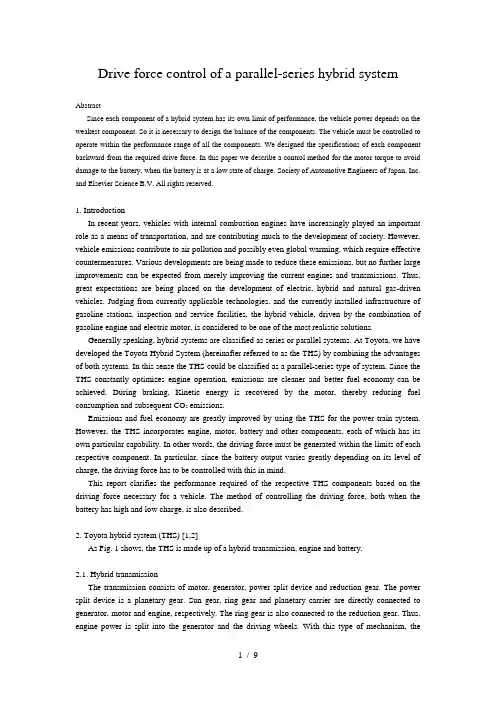
Drive force control of a parallel-series hybrid systemAbstractSince each component of a hybrid system has its own limit of performance, the vehicle power depends on the weakest component. So it is necessary to design the balance of the components. The vehicle must be controlled to operate within the performance range of all the components. We designed the specifications of each component backward from the required drive force. In this paper we describe a control method for the motor torque to avoid damage to the battery, when the battery is at a low state of charge. Society of Automotive Engineers of Japan, Inc. and Elsevier Science B.V. All rights reserved.1. IntroductionIn recent years, vehicles with internal combustion engines have increasingly played an important role as a means of transportation, and are contributing much to the development of society. However, vehicle emissions contribute to air pollution and possibly even global warming, which require effective countermeasures. Various developments are being made to reduce these emissions, but no further large improvements can be expected from merely improving the current engines and transmissions. Thus, great expectations are being placed on the development of electric, hybrid and natural gas-driven vehicles. Judging from currently applicable technologies, and the currently installed infrastructure of gasoline stations, inspection and service facilities, the hybrid vehicle, driven by the combination of gasoline engine and electric motor, is considered to be one of the most realistic solutions.Generally speaking, hybrid systems are classified as series or parallel systems. At Toyota, we have developed the Toyota Hybrid System (hereinafter referred to as the THS) by combining the advantages of both systems. In this sense the THS could be classified as a parallel-series type of system. Since the THS constantly optimizes engine operation, emissions are cleaner and better fuel economy can be achieved. During braking, Kinetic energy is recovered by the motor, thereby reducing fuel consumption and subsequent CO2 emissions.Emissions and fuel economy are greatly improved by using the THS for the power train system. However, the THS incorporates engine, motor, battery and other components, each of which has its own particular capability. In other words, the driving force must be generated within the limits of each respective component. In particular, since the battery output varies greatly depending on its level of charge, the driving force has to be controlled with this in mind.This report clarifies the performance required of the respective THS components based on the driving force necessary for a vehicle. The method of controlling the driving force, both when the battery has high and low charge, is also described.2. Toyota hybrid system (THS) [1,2]As Fig. 1 shows, the THS is made up of a hybrid transmission, engine and battery.2.1.Hybrid transmissionThe transmission consists of motor, generator, power split device and reduction gear. The power split device is a planetary gear. Sun gear, ring gear and planetary carrier are directly connected to generator, motor and engine, respectively. The ring gear is also connected to the reduction gear. Thus, engine power is split into the generator and the driving wheels. With this type of mechanism, therevolutions of each of the respective axes are related as follows. Here, the gear ratio between the sun gear and theFig. 1. Schematic of Toyota hybrid system (THS).ring gear is ρ:where Ne is the engine speed, Ng the generator speed and Nm the motor speed.Torque transferred to the motor and the generator axes from the engine is obtained as follows:where Te is the engine torque.The drive shaft is connected to the ring gear via a reduction gear. Consequently, motor speed and vehicle speed are proportional. If the reduction gear ratio isη, the axle torque is obtained as follows:where Tm is the motor torque.As shown above, the axle torque is proportional to the total torque of the engine and the motor on the motor axis. Accordingly, we will refer to motor axis torque instead of axle torque.2.2. EngineA gasoline engine having a displacement of 1.5 l specially designed for the THS is adopted [3]. This engine has high expansion ratio cycle, variable valve timing system and other mechanisms in order to improve engine efficiency and realize cleaner emissions. In particular, a large reduction in friction is achieved by setting the maximum speed at 4000 rpm (=Ne max).2.3. BatteryAs sealed nickel metal hydride battery is adopted. The advantages of this type of battery are high power density and long life. this battery achieves more than three times the power density of those developed for conventional electric vehicles [4].3. Required driving force and performanceThe THS offers excellent fuel economy and emissions reduction. But it must have the ability to output enough driving force for a vehicle. This section discusses the running performance required of the vehicle and the essential items required of the respective components.Road conditions such as slopes, speed limits and the required speed to pass other vehicles determine the power performance required by the vehicle. Table 1 indicates the power performance needed in Japan.3.1. Planetary gear ratioρThe planetary gear ratio (ρ) has almost no effect on fuel economy and/or emissions. This is because the required engine power (i.e. engine condition) depends on vehicle speed, driving force and battery condition, and not on the planetary gear ratio. Conversely, it is largely limited by the degree of installability in the vehicle and manufacturing aspects, leaving little room for design. In the currently developed THS, ρ=0.385.3.2. Maximum engine powerSince the battery cannot be used for cruising due to its limited power storage capacity, most driving is reliant on engine power only. Fig. 2 shows the power required by a vehicle equipped with the THS, based on its driving resistance. Accordingly, the power that is required for cruising on a level road at 140 km/h or climbing a 5% slope at 105 km/h will be 32 kW. If the transmission loss is taken into account, the engine requires 40 kW (=Pe max) of power. The THS uses an engine with maximum power of 43 kW in order to get good vehicle performance while maintaining good fuel economy.3.3. Maximum generator torqueAs described in Section 2, the maximum engine speed is 4000 rpm (=Ne max). To attain maximum torque at this speed, maximum engine torque is obtained as follows:From Eq. (3), the maximum torque on the generator axis will be as follows:This is the torque at which the generator can operate without being driven to over speed. Actually, higher torque is required because of acceleration/deceleration of generator speed and dispersion of engine and/or generator torque. By adding 40% torque margin to the generator, the necessary torque is calculated as follows:3.4. Maximum motor torqueFrom Fig. 3, it can be seen that the motor axis needs to have a torque of 304 Nm to acquire the 30% slope climbing performance. This torque merely balances the vehicle on the slope. To obtain enough starting and accelerating performance, it is necessary to have additional torque of about 70 Nm, or about 370 Nm in total.From Eq. (2), the transmitted torque from the engine is obtained as follows:Consequently, a motor torque of 300 Nm (=T m max) is necessary.3.5. Maximum battery powerAs Fig. 2 shows, driving power of 49 kW is needed for climbing on a 5%slope at 130 km/h. Thus, the necessary battery power is obtained by subtracting the engine-generated power from this. As already discussed, if an engine having the minimum required power is installed, it can only provide 32 kW of power, so the required battery power will be 17 kW. If the possible loss that occurs when the battery supplies power to the motor is taken into account, battery power of 20 kW will be needed. Thus, it is necessary to determine the battery capacity by targeting this output on an actual slope. Table 2 lists the required battery specifications.Table 3 summarizes the specifications actually adopted by the THS and the requirements determined by the above discussion. The required items represent an example when minimum engine power is selected. In other words, if the engine is changed, each of the items have to be changed accordingly.4. Driving force controlThe THS requires controls not necessary for conventional or electric vehicles in order to controlthe engine, motor and generator cooperatively. Fig. 4 outlines the control system.Fig. 4. Control diagram of the THS.Inputs of control system are accelerator position, vehicle speed (motor speed), generator speed and available battery power. Outputs are the engine-required power, generator torque and motor torque.First, drive torque demanded by the driver (converted to the motor axis) is calculated from the accelerator position and the vehicle speed. The necessary drive power is calculated from this torque and the motor speed. Required power for the system is the total of the required drive power, the required power to charge the battery and the power loss in the system. If this total required power exceeds the prescribed value, it becomes required engine power. If it is below the prescribed value, the vehicle runs on the battery without using the engine power. Next, the most efficient engine speed for generating engine power is calculated; this is the engine target speed. The target speed for the generator is calculated using Eq. (1) with engine target speed and motor speed. The generator torque is determined by PID control. Engine torque can be calculated in reverse by using Eq. (3) and the torque transferred from the engine to the motor axis can be calculated from (2). The motor torque is obtained by subtracting this torque from the initially calculated drive torque. Since it is not possible to produce a torque whereby the motor consumption power exceeds the total of the generator-generated power and the power supplied by the battery, it is necessary to control the motor power (torque) within this total power. Fig. 5 shows the control method. The sum of the power form the generator and the available battery power become the power that can be used by the motor. The available motor torque can be obtained by dividing this combined power by the motor speed. When the motor speed is low, if the calculated motor torque exceeds the motor specification of torque the motor torque is determined by the specification. By controlling the motor torque requirement with this limited torque, the motor consumption power can be controlled to within the available power. If the available battery power is large enough, the available motor torque hardly limits the motor torque. Conversely, when the charge is low, the motor torque is frequently limited.Fig. 6 shows the respective maximum drive torque of the battery, the engine, and the engine plus the battery while running based on the controls above, when the THS has the components as specified in Section 3.5. ConclusionsThis paper discussed the control of drive power in the Toyota Hybrid System. The following conclusions were obtained:●The performance required for each component can be determined by reversely calculating powerperformance required for a vehicle.●The available battery power varies according to its state of charge. However, by limiting themotor torque, the battery power can be controlled to within the battery's available power.混合动力系统驱动力的串并联控制摘要由于混合动力系统的每个部分都有自己的极限性能,所以汽车动力取决于最脆弱的哪一个组成部分。
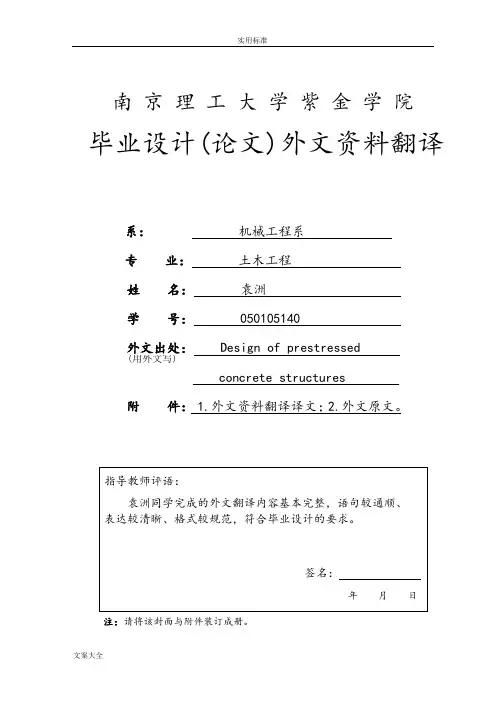
南京理工大学紫金学院毕业设计(论文)外文资料翻译系:机械工程系专业:土木工程姓名:袁洲学号: 050105140外文出处:Design of prestressed(用外文写)concrete structures附件: 1.外文资料翻译译文;2.外文原文。
附件1:外文资料翻译译文8-2简支梁布局一个简单的预应力混凝土梁由两个危险截面控制:最大弯矩截面和端截面。
这两部分设计好之后,中间截面一定要单独检查,必要时其他部位也要单独调查。
最大弯矩截面在以下两种荷载阶段为控制情况,即传递时梁受最小弯矩M G的初始阶段和最大设计弯矩M T时的工作荷载阶段。
而端截面则由抗剪强度、支承垫板、锚头间距和千斤顶净空所需要的面积来决定。
所有的中间截面是由一个或多个上述要求,根它们与上述两种危险截面的距离来控制。
对于后张构件的一种常见的布置方式是在最大弯矩截面采用诸如I形或T 形的截面,而在接近梁端处逐渐过渡到简单的矩形截面。
这就是人们通常所说的后张构件的端块。
对于用长线法生产的先张构件,为了便于生产,全部只用一种等截面,其截面形状则可以为I形、双T形或空心的。
在第5 、 6 和7章节中已经阐明了个别截面的设计,下面论述简支梁钢索的总布置。
梁的布置可以用变化混凝土和钢筋的办法来调整。
混凝土的截面在高度、宽度、形状和梁底面或者顶面的曲率方面都可以有变化。
而钢筋只在面积方面有所变化,不过在相对于混凝土重心轴线的位置方面却多半可以有变化。
通过调整这些变化因素,布置方案可能有许多组合,以适应不同的荷载情况。
这一点是与钢筋混凝土梁是完全不同的,在钢筋混凝土梁的通常布置中,不是一个统一的矩形截面便是一个统一的T形,而钢筋的位置总是布置得尽量靠底面纤维。
首先考虑先张梁,如图 8-7,这里最好采用直线钢索,因为它们在两个台座之间加力比较容易。
我们先从图(a)的等截面直梁的直线钢索开始讨论。
这样的布置都很简单,但这样一来,就不是很经济的设计了,因为跨中和梁端的要求会产生冲突。
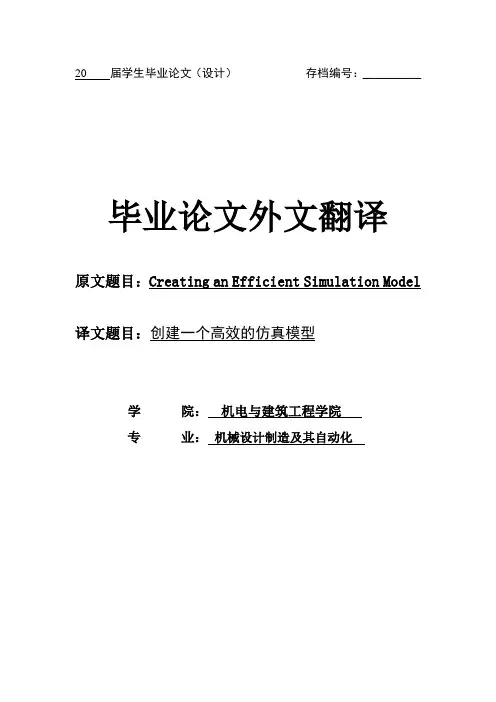
20 届学生毕业论文(设计)存档编号:__________毕业论文外文翻译原文题目:Creating an Efficient Simulation Model 译文题目:创建一个高效的仿真模型学院:机电与建筑工程学院专业:机械设计制造及其自动化在本章中,我们描述的数值模拟软件的总体结构实现一个高效的仿真模型,在不同的步骤。
5.1数值模拟软件的总体结构数值模拟软件由三个主要部件预处理,求解和后处理,如图所示。
5.1。
图5.1。
数值模拟软件的主要组成部分前和后处理被纳入了一个交互式图形用户界面(GUI)。
求解器启动,并从这个接口控制。
虽然今天的用户可能会觉得只有一个软件,该司825创建一个高效的仿真模型软件分为三个主要部分组成,从逻辑和说教感观点。
5.1.1预处理预处理器用于建立仿真模型,如图。
5.2。
图5.2。
基本的仿真模型,包括天线的几何尺寸,材料性能,港口,边界条件,为近场录音盒我们在下面的列表给出一个简短的概述,在处理的任务在模型生成的过程。
每个项目的解释在随后的章节中更多的细节。
一般定义:在这个阶段,不同层次或组件定义组织的数据。
此外,物理量的单位被选中,例如,长度以毫米为单位,在主频。
几何对象的几何形状的定义。
中有一般三种不同的方法,可以结合几何进入交互图形用户界面(GUI),几何导入数据从一个CAD文件,或描述的对象是由一个宏语言。
材料性能:介电性能被分配到几何已在第一步为蓝本的对象。
材料选择从数据库中预定义的常用材料或新材料是指通过指定的介质和磁学性质。
激励:端口都定义为了激发结构和评估基于电路。
5.1一般结构的数值模拟软件边界条件:在不同的模拟量的外部边界各种边界条件适用于以代表自由空间,电场和磁场的墙壁或对称平面。
啮合:离散成小分子结构与均匀材料的性能。
该模型的离散化是至关重要的一步,因为它会影响所需的数值的努力和解决方案的准确性。
仿真参数:定义额外的参数控制解决方案的过程中,例如,要使用一种求解,定义一个endcriterion时间步进算法,所需的精度,AR滤波,多激励,端口模式。
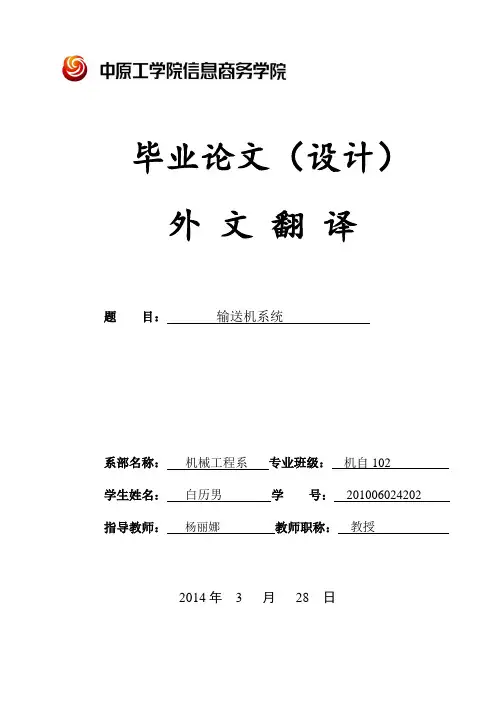
毕业论文(设计)外文翻译题目:输送机系统系部名称:机械工程系专业班级:机自102学生姓名:白历男学号:201006024202指导教师:杨丽娜教师职称:教授2014年 3 月28 日译文:输送机系统输送机时使用的材料必须在特定位置之间相对大量贴路径。
固定路径由一个跟踪系统实现,这可能是in-the-floor,above-the-floor,或开销。
输送机分为两个基本类别:(1)powered和(2)no-powered。
在驱动输送机,权力机制包含在固定的路径,使用链、腰带、旋转卷,或其他设备驱动加载路径。
驱动输送机常用的自动化物料运输系统在制造工厂,仓库,配送中心。
在non-powered输送机,材料是由人类工人搬手动推动沿固定路径加载或重力在海拔较低的海拔高度。
输送机的类型各种输送商用设备。
在下面的文章中,我们描述了驱动输送机的主要类型,根据组织类型的机械功率提供了固定的路径。
辊和溜冰轮输送机。
这些输送带卷或车轮上加载。
负载必须具备足够的平底表面区域跨几个相邻的滚轴。
托盘、手提包锅,或纸箱很好地服务于这个目的。
这个类别中的两个主要入口辊道输送机和溜冰轮输送机。
辊道输送机的途径由一系列管(滚筒)垂直的方向旅行。
辊是包含在一个固定的框架,提升上述通路地板水平从几英寸到几英尺。
平面托盘或手提包锅携带单位负载辊旋转前进。
辊道输送机可以驱动或non-powered。
动力滚筒输送机驱动皮带或链条。
non-powered 辊道输送机通常由重力比路径有一个向下的斜坡足以克服滚动摩擦。
辊道输送机用于各种各样的应用程序,包括生产、组装、包装、分类和分布。
Skate-wheel输送机在操作辊道输送机是相似的。
而不是辊,它们使用滑板车轮转动轴连接到框架上,托盘或手提包锅或其他容器沿路径。
这为滑板轮输送机提供了一个更轻的重量比辊子输送机建设。
应用Skate-wheel输送机是辊道输送机的类似,除了交往以来的负载通常必须轻负荷和输送机必须更加集中。
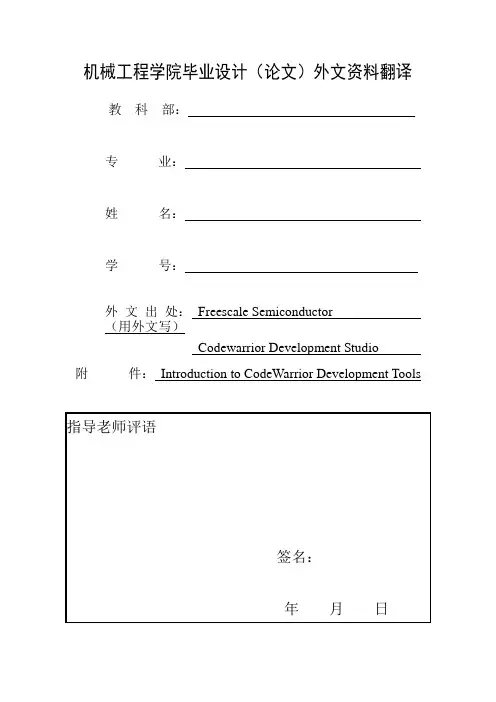
机械工程学院毕业设计(论文)外文资料翻译教科部:专业:姓名:学号:外文出处:Freescale Semiconductor(用外文写)Codewarrior Development Studio附件:Introduction to CodeWarrior Development ToolsCodeWarrior介绍一、CodeWarrior 能做些什么?当你知道自己能写更好的程序时,你一定不会再使用别人开发的应用程序。
但是常常会发生这种情况,就是当你写了无数行代码后,却找不到使得整个程序出错的那一行代码,这会让你感到很失望,更不用提编译和链接整个程序等其它的了。
使用CodeWarrior 这一工具解决上述问题。
在CodeWarrior 中使用C/C++ 进行编程。
CodeWarrior 也可以支持Java 开发,但那是另一门课程的内容。
CodeWarrior 能够自动地检查代码中的明显错误,它通过一个集成的调试器和编辑器来扫描你的代码,以找到并减少明显的错误,然后编译并链接程序以便计算机能够理解并执行你的程序。
你所使用过的每个应用程序都经过了使用象CodeWorrior 这样的开发工具进行编码、编译、编辑、链接和调试的过程。
你可以使用CodeWarrior 来编写你能够想象得到的任何一种类型的程序。
如果你是一个初学者,你可以选择编写一个应用程序(比如一个可执行程序),比如象微软公司的文本编辑器WordPad 这样的应用程序。
应用程序可能是最容易编写的程序了,而那些庞大的商业软件,比如象Adobe Photoshop,Microsoft Word 以及CodeWarrior 软件都是极其复杂的。
其它类型的程序指的是控制面板(control panels),动态链接库(dynamic linked libraries,DLLs) 和插件(plug-ins)。
我们先来简单的讨论一下这些类型的程序。
在Windows 中,控制面板程序是一些(通常比较小的)存放在控制面板目录下的程序,可以在开始菜单的控制面板项中看到它们。
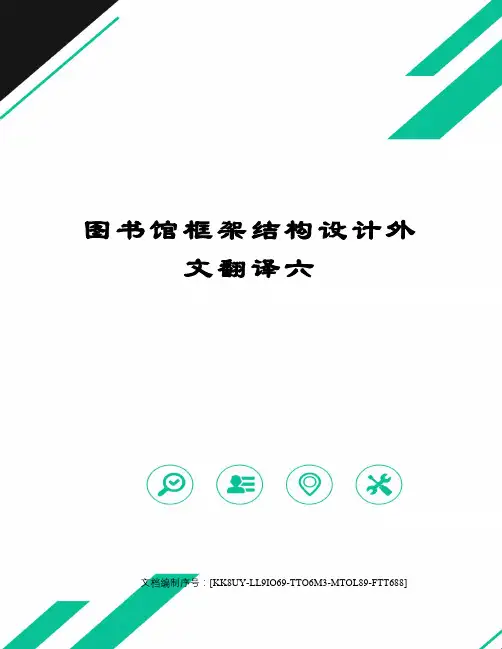
图书馆框架结构设计外文翻译六文档编制序号:[KK8UY-LL9IO69-TTO6M3-MTOL89-FTT688]南 京 理 工 大 学 紫 金 学 院毕业设计(论文)外文资料翻译系: 机械工程系专 业: 土木工程姓 名: 袁洲学 号: 0外文出处: Design of prestressed concrete structures附 件: 1.外文资料翻译译文;2.外文原文。
注:请将该封面与附件装订成册。
(用外文写)附件1:外文资料翻译译文8-2简支梁布局一个简单的预应力混凝土梁由两个危险截面控制:最大弯矩截面和端截面。
这两部分设计好之后,中间截面一定要单独检查,必要时其他部位也要单独调查。
最大弯矩截面在以下两种荷载阶段为控制情况,即传递时梁受最小弯矩MG 的初始阶段和最大设计弯矩MT时的工作荷载阶段。
而端截面则由抗剪强度、支承垫板、锚头间距和千斤顶净空所需要的面积来决定。
所有的中间截面是由一个或多个上述要求,根它们与上述两种危险截面的距离来控制。
对于后张构件的一种常见的布置方式是在最大弯矩截面采用诸如I形或T形的截面,而在接近梁端处逐渐过渡到简单的矩形截面。
这就是人们通常所说的后张构件的端块。
对于用长线法生产的先张构件,为了便于生产,全部只用一种等截面,其截面形状则可以为I形、双T形或空心的。
在第5 、6 和7章节中已经阐明了个别截面的设计,下面论述简支梁钢索的总布置。
梁的布置可以用变化混凝土和钢筋的办法来调整。
混凝土的截面在高度、宽度、形状和梁底面或者顶面的曲率方面都可以有变化。
而钢筋只在面积方面有所变化,不过在相对于混凝土重心轴线的位置方面却多半可以有变化。
通过调整这些变化因素,布置方案可能有许多组合,以适应不同的荷载情况。
这一点是与钢筋混凝土梁是完全不同的,在钢筋混凝土梁的通常布置中,不是一个统一的矩形截面便是一个统一的T形,而钢筋的位置总是布置得尽量靠底面纤维。
首先考虑先张梁,如图 8-7,这里最好采用直线钢索,因为它们在两个台座之间加力比较容易。
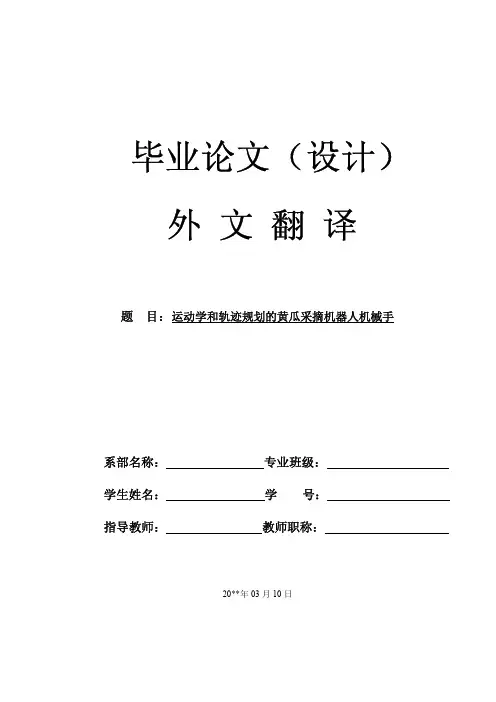
毕业论文(设计)外文翻译题目:运动学和轨迹规划的黄瓜采摘机器人机械手系部名称:专业班级:学生姓名:学号:指导教师:教师职称:20**年03月10日运动学和轨迹规划的黄瓜采摘机器人机械手摘要:为了降低成本,提高黄瓜收获经济效益,黄瓜收获机器人得以发展。
黄瓜果蔬采摘机器人由一辆汽车,一个四自由度关节机械手,一个手端,一个上一个视觉系统与监控、四直流伺服驱动系统组成。
把黄瓜的运动学果蔬采摘机器人机械手使用D-H标系建立了框架模型。
而且它提供了一个逆运动学轨迹规划的基础已经解决了逆变换技术。
摆线针轮运动,它具有的性能的连续性和零速度和加速度的港口及有界区间,采用一种可行的方法在关节空间轨迹规划,研究了果蔬采摘机器人的机械臂的黄瓜。
此外,硬件和摘要软件基于上面的显示器之间的交流及关节的控制器的设计。
实验结果表明,上面的显示器与四关节控制器的沟通,有效地摘要错误的思想和综合四关节角不超过四度。
误差产生的可能因素分析及相应的解决方案,为提高测量精度的措施提出了建议。
关键词:黄瓜果蔬采摘机器人轨迹规划、关节机械臂、运动、摘要、摆线针轮分类号:10.3965/j.issn.1934-6344.2009.01.001-007。
引文:张利兵,杨庆华,宝冠君,高锋,薰易。
运动学和轨迹规划黄瓜收获机器人的机械手。
农业与生物学工程,2009;2(1):1-7。
一.介绍水果和蔬菜的收获是一个劳力密集的工作,由人类劳动和收获的成本大约是33%〜总数的50%,生产成本[1]。
因此,机械化和自动化,迫切需要水果和蔬菜收获。
目前,许多国家正在研究。
收稿日期:08-11-20接受日期:009-03-28传记:张利兵,教授,博士,主要从事农业机器人,机电一体化和控制。
王雁,博士候选人浙江工业大学,主要从事,机器人,智能仪表。
杨庆华,教授,博士,主要从事机器人技术,机电一体化和控制。
宝冠君,讲师,博士,主要从事机器人技术,控制人数及机器视觉。
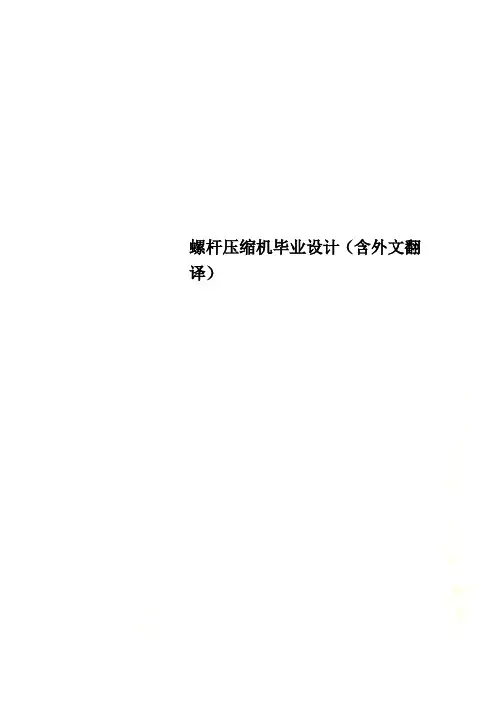
螺杆压缩机毕业设计(含外文翻译)华东交通大学毕业设计(论文)任务书毕业设计开题报告书螺杆压缩机的介绍双螺杆压缩机属于回转式压缩机,是一种工作容积作旋转运动的容积式气体压缩机械。
气体的压缩是通过容积的变化来实现,而容积的变化又是借压缩机的一个或几个转子在气缸里作旋转运动来达到。
回转式压缩机的工作容积不同于往复式压缩机,它除了周期性地扩大和缩小外,其空间位置也在变更。
回转式压缩机靠容积的变化来实现气体的压缩,这一点与往复式压缩机相同,它们都属于容积式压缩机;回转式压缩机的主要机件(转子)在气缸内作旋转运动,这一点又与速度式压缩机相同。
所以,回转式压缩机同时兼有上述两类机器的特点。
回转式压缩机没有往复运动机构,一般没有气阀,零部件(特别是易损件)少,结构简单、紧凑,因而制造方便,成本低廉;同时,操作简便,维修周期长,易于实现自动化。
回转式压缩机的排气量与排气压力几乎无关,与往复式压缩机一样,具有强制输气的特征。
回转式压缩机运动机件的动力平衡性良好,故压缩机的转数高、基础小。
这一优点,在移动式机器中尤为明显。
回转式压缩机转数高,它可以和高速原动机(如电动机、内燃机、蒸汽轮机等)直接相联。
高转数带来了机组尺寸小、重量轻的优点。
同时,在转子每转一周之内,通常有多次排气过程,所以它输气均匀、压力脉动小,不需设置大容量的储气罐。
回转式压缩机的适应性强,在较大的工况范围内保持高效率。
排气量小时,不像速度式压缩机那样会产生喘振现象。
在某些类型的回转式压缩机(如罗茨鼓风机、螺杆式压缩机)中,运动机件相互之间,以及运动机件与固定机件之间,并不直接接触,在工作容积的周壁上无需润滑,可以保证气体的洁净,做到绝对无油的压送气体(这类机器成为无油回转压缩机)。
同时,由于相对运动的机件之间存在间隙以及没有气阀,故它能压送污浊和带液滴、含粉尘的气体。
但是,回转式压缩机也有它的缺点,这些缺点是:由于转数较高,加之工作容积与吸排气孔口周期性地相通、切断,产生较为强烈的空气动力噪声,其中螺杆式压缩机、罗茨鼓风机尤为突出,若不采取消音措施,即不能被用户所利用。
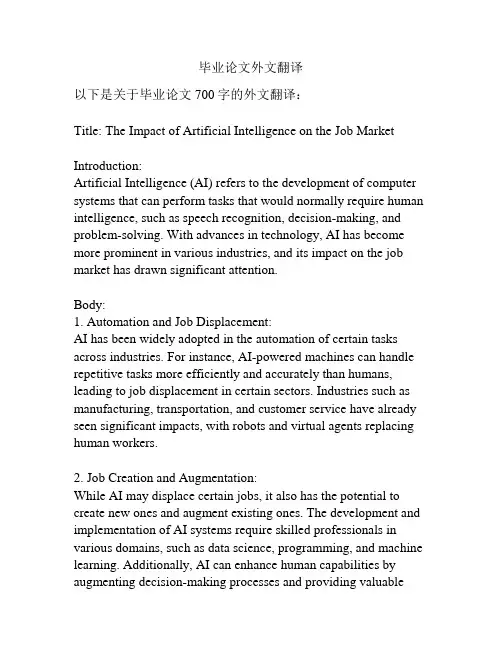
毕业论文外文翻译以下是关于毕业论文700字的外文翻译:Title: The Impact of Artificial Intelligence on the Job Market Introduction:Artificial Intelligence (AI) refers to the development of computer systems that can perform tasks that would normally require human intelligence, such as speech recognition, decision-making, and problem-solving. With advances in technology, AI has become more prominent in various industries, and its impact on the job market has drawn significant attention.Body:1. Automation and Job Displacement:AI has been widely adopted in the automation of certain tasks across industries. For instance, AI-powered machines can handle repetitive tasks more efficiently and accurately than humans, leading to job displacement in certain sectors. Industries such as manufacturing, transportation, and customer service have already seen significant impacts, with robots and virtual agents replacing human workers.2. Job Creation and Augmentation:While AI may displace certain jobs, it also has the potential to create new ones and augment existing ones. The development and implementation of AI systems require skilled professionals in various domains, such as data science, programming, and machine learning. Additionally, AI can enhance human capabilities by augmenting decision-making processes and providing valuableinsights.3. Skill Shifts and Reskilling:With the rapid advancement of AI, certain skills may become less in demand while others may become more valuable. For example, skills such as data analysis, coding, and problem-solving are becoming increasingly important in the AI-driven job market. As a result, individuals may need to reskill or upskill to remain competitive in the workforce.4. Impact on Specific Industries:Certain industries are expected to be significantly impacted by AI. For instance, the healthcare industry can benefit from AI-powered diagnostic tools and predictive models. Likewise, the finance industry can leverage AI to improve fraud detection and risk assessment. However, these advancements may also lead to job displacement in certain roles, such as medical coders and financial analysts.Conclusion:The growth of AI technology has both positive and negative impacts on the job market. While it may lead to job displacement in certain sectors, it also has the potential to create new job opportunities and augment existing ones. In order to adapt to the changing job market, individuals may need to acquire new skills and embrace lifelong learning. Policymakers also have a role to play in facilitating the transition and ensuring the benefits of AI are distributed equitably.。
--工程大学邮电与信息工程学院毕业设计(论文)外文资料翻译原文题目:Effectively Design Shell-and-TubeHeat Exchangers原文来源:Chemical Engineering ProgressFebruary 1998文章译名:管壳式换热器的优化设计姓名:xxx学号:62021703xx指导教师(职称):王成刚(副教授)专业:过程装备与控制工程班级:03班所在学院:机电学部- -教育-管壳式换热器的优化设计为了充分利用换热器设计软件,我们需要了解管壳式换热器的分类、换热器组件、换热管布局、挡板、压降和平均温差。
管壳式换热器的热设计是通过复杂的计算机软件完成的。
然而,为了有效使用该软件,需要很好地了解换热器设计的基本原则。
本文介绍了传热设计的基础,涵盖的主题有:管壳式换热器组件、管壳式换热器的结构和使用围、传热设计所需的数据、管程设计、壳程设计、换热管布局、挡板、壳程压降和平均温差。
关于换热器管程和壳程的热传导和压力降的基本方程已众所周知。
在这里,我们将专注于换热器优化设计中的相关应用。
后续文章是关于管壳式换热器设计的前沿课题,例如管程和壳程流体的分配、多壳程的使用、重复设计以及浪费等预计将在下一期介绍。
管壳式换热器组件至关重要的是,设计者对管壳式换热器功能有良好的工作特性的认知,以及它们如何影响换热设计。
管壳式换热器的主要组成部分有:壳体封头换热管管箱管箱盖管板折流板接管其他组成部分包括拉杆和定距管、隔板、防冲挡板、纵向挡板、密封圈、支座和地基等。
管式换热器制造商协会标准详细介绍了这些不同的组成部分。
管壳式换热器可分为三个部分:前端封头、壳体和后端封头。
图1举例了各种结构可能的命名。
换热器用字母编码描述三个部分,例如,BFL 型换热器有一个阀盖,双通的有纵向挡板的壳程和固定的管程后端封头。
根据结构固定管板式换热器:固定管板式换热器(图2)装有直的换热管,这些管束两端固定在管板上,管板则被焊接在壳体上。
本科生毕业设计(论文)外文翻译毕业设计(论文)题目:基于PLC的自动化立体车库控制系统设计__ 外文题目:PLC control three-dimensional garage system design _ 译文题目:PLC控制的立体车库系统设计学生姓名:徐芳菲_______________专业:自动化_______________指导教师姓名:于冬梅________________评阅日期:_____________________PLC控制的立体车库系统设计Ho Gi Jung*,Chi Gun Choi ,Dong Suk kim ,Pal Joo YoonMANDO CorporationZIP446-901,413-5,Gomae-Dong,Giheung-Gu,Yongin-si,Kyonggi-Do,Korea 摘要:立体停车库生产在中国是个新兴行业,立体停车库可缓解城市动、静态交通问题,改善居住环境,有效利用土地价值。
本系统采用PLC、计算机结合组态画面监控,按动按钮或控制组态画面即可完成汽车存取过程,操作简单,存取方便。
控制电路部分采用交流接触器传统方式,使运行安全可靠。
设计采用可分组合,模块式安装,方便灵活,具备维护使用方便,造价低等特点。
关键词:立体车库可编程控制器组态监控Ⅰ.引言车辆无处停放的问题是城市的社会、经济、交通发展到一定程度产生的结果,立体停车设备的发展在国外,尤其在日本已有近30~40年的历史,无论在技术上还是在经验上均已获得了成功。
我国也于90年代初开始研究开发机械立体停车设备,距今已将近二十年的历程。
由于很多新建小区内住户与车位的配比为1:1,为了解决停车位占地面积与住户商用面积的矛盾,立体机械停车设备以其平均单车占地面积小的独特特性,已被广大用户接受。
机械车库与传统的自然地下车库相比,在许多方面都显示出优越性。
首先,机械车库具有突出的节地优势。
以往的地下车库由于要留出足够的行车通道,平均一辆车就要占据40平方米的面积,而如果采用双层机械车库,可使地面的使用率提高80%—90%,如果采用地上多层(21层)立体式车库的话,50平方米的土地面积上便可存放40辆车,这可以大大地节省有限的土地资源,并节省土建开发成本。
苏州科技学院毕业论文外文翻译外文题目单向增强纤维振动辅助切削中的力学和材料去除机制院 (系) 机械工程学院专业机械设计制造及其自动化学生姓名张明光学号 11200136203 指导教师殷振2015 年 3 月 14 日单向增强纤维振动辅助切削中的力学和材料去除机制关键词:纤维增强聚合物基复合材料;振动辅助切削;切削力学;材料去除机理;纤维 - 基体剥离。
摘要本文旨在揭示背后的单向网络BRE振动辅助切削(VAC)的材料去除机制和力学增强复合材料(FRP)复合材料。
通过整合VAC的核心因素,包括网络BRE 方向和变形,纤维 - 基体界面,工具,网络BRE接触和工具 - 工件接触的综合分析,研制成功预测的切削力可靠的力学模型流程。
进行有关的实验表明,该模型已捕获在切割玻璃钢复合材料的力学和主要变形机制,并且在任一所述的切割或法线方向超声波振动的应用程序可以显著降低切削力,最小化网络连接BRE 形变,促进有利科幻BRE骨折在切割界面,并在很大程度上提高加工表面的质量。
当振动被施加到两个所述切割和法线方向,刀尖的椭圆振动轨迹可以带来一个最佳的切割过程。
存在切口的临界深度,超过该音响BRE矩阵剥离深度由施加在刀尖的振动不再影响。
这大大阻碍了EVA切削技术的优化与应用。
本文旨在为解决上述问题进行了详细的力学分析,了解单向ERP材料EVA 切削所用到的原理并建立必要的基础。
1.简介纤维增强型复合材料(FRP)因其强度、刚度高,质量轻的特点而被广泛应用于先进结构中。
然而,由于纤维和基体机械性能的显著差异,FRP材料产品很难被加工。
因而,加工后的FRP产品经常有着各种缺陷,如纤维露出、纤维断裂、基体开裂、纤维与基体脱粘和分层等。
目前为止,大多数对FRP材料加工的实验主要针对有以下几个方面:纤维或基质类型的影响、纤维体积分数及方向的影响、刀具材料及形状的影响、切削深度的影响和所选用加工参数的影响。
然而,这些研究局限于传统的加工方法,如车、铣、钻,仍面临着上文突出的表面缺陷。
毕业设计(论文)外文文献翻译文献、资料中文题目:汽车变速器设计文献、资料英文题目:Transmission design文献、资料来源:文献、资料发表(出版)日期:院(部):专业:机械设计制造及其自动化班级:姓名:学号:指导教师:翻译日期: 2017.02.14毕业论文(设计)外文文献翻译汽车变速器设计我们知道,汽车发动机在一定的转速下能够达到最好的状态,此时发出的功率比较大,燃油经济性也比较好。
因此,我们希望发动机总是在最好的状态下工作。
但是,汽车在使用的时候需要有不同的速度,这样就产生了矛盾。
这个矛盾要通过变速器来解决。
汽车变速器的作用用一句话概括,就叫做变速变扭,即增速减扭或减速增扭。
为什么减速可以增扭,而增速又要减扭矩呢?设发动机输出的功率不变,功率可以表示为N=wT,其中w是转动的角速度,T是扭矩。
当N固定的时候,w与T是成反比的。
所以增速必减扭矩,减速必增扭矩。
汽车变速器齿轮传动就根据变速变扭的原理,分成各个档位对应不同的传动比,以适应不同的运行状况。
一般的手动变速器内设置输入轴、中间轴和输出轴,又称三轴式,另外还有倒档轴。
三轴式是变速器的主体结构,输入轴的转速也就是发动机的转速,输出轴转速则是中间轴与输出轴之间不同齿轮啮合所产生的转速。
不同的齿轮啮合就有不同的传动比,也就有了不同的转速。
例如郑州日产ZN6481W2G型SUV车手动变速器,它的传动比分别是:1档3.704:1;2档2.202:1;3档1.414:1;4档1:1;5档(超速档)0.802:1。
当汽车启动司机选择1档时,拨叉将1/2档同步器向后接合1档齿轮并将它锁定输出轴上,动力经输入轴、中间轴和输出轴上的1档齿轮,1档齿轮带动输出轴,输出轴将动力传递到传动轴上(红色箭头)。
典型1档变速齿轮传动比是3:1,也就是说输入轴转3圈,输出轴转1圈。
当汽车增速司机选择2档时,拨叉将1/2档同步器与1档分离后接合2档齿轮并锁定输出轴上,动力传递路线相似,所不同的是输出轴上的1档齿轮换成2档齿轮带动输出轴。
毕业论文外文翻译题目:装载机国内现状与市场开发之分析专业:机械设计制造及其自动化班级:机升111 班学号:姓名:指导教师:Domestic Market Present Situation And The Development Of TheExcavating Loader AnalysisThe loader digger is so called “two favour”. Because it has special structure, loads device being the head and the equipment for the excavation behind. in the workplace , you need to turn the chair, completing the change from loader to the excavator loader digger is mainly used for the highway construction and protect of the city and village, the electric cable build, electric power and airport engineering, municipal services construction, farmland irrigation construction, village residence construction, opening mountain to take stone and various small scaled and multi-function engineering machine, generally used in the small project after the completion of the big ones.FIRST: A CLASSIFICATION OF THE LOADERDIGGER The loader digger is so called “two favour”having two kinds of funcitions of lading and scooping out in the meantime. The classifications are as fallows ONE: from the structureAccording to the structure, loader diggers have two kinds of forms: one is with oblique tones move frame, the dinging device can be moved with side, which is easy to work in the special place, the center of gravity is lower when it transports. It is advantageous to loading and transporting. The weakness is: because of the restriction of the structure, the ground jack usually adopts vertical leg. The supporting point is within the wheel edge, the distance of the two supporting point is relatively small. While scooping the whole machine’s stability is bad. ( especially the scooping device moves to one side). The functional main point of this kind of machine is in the aspects of loading, producing more in Europe ; the excavation device of the latter can’t move to side, the whole excavation device can make 180°turn-over through the rotary supporting, the ground jack is like the frog leg, the supporting point can stretch outside side the wheel, the stability is good when excavating, which is advantageous to the exaltation of with excavation ability. Because having no oblique tones move frame, the cost of the whole machine is lower. The weakness is the bucket hangs at the truck’s tail, the size is long, when the locomotive is in conveyance and loads, the stability is bad , which has certain scooping, with the US producing most.TWO: from the motive allotmentFrom the motive allotment, the loader digger has two kinds of forms: two-wheel(rear-wheel) to drive and four-wheel(whole round)to drive. the former can’tmake use of adherence to weight completely, making the adhesive strength of motorcycle and ground and the leading force are to descend, but the cost is much lower than the latter.THREE:of the bedrockFrom the bedrock, among the 3 kinds of common bedrocks used in the small scaled and multi-function engineering machine, the motive of the miniature loader digger is mostly below 20 KW, the height of the whole machine is 1000-3000Kg,adopting track-run structure, the speed dose not reach 5km/h usually used for the yardage processing of small scales, such as farm and park…etc.Because its model is partial to small, cost is higher is 30-60KW, the weight is relatively heave, about 5000-8000Kg, the scooping ability is strong, uses wheeled walks the structure, driven by the whole round, making use of the turn round driving axle or hinge joint, the car speed is higher, reaching to 20km/h, the abroad usually use it as assistance work for the yardage processing and large-scale fabricating yard of farm, capital construction, road maintainance…etc. this model’s shape is bigger, the flexibility is worse, generally it hard to adapt the work of narrow and small place.SECOND: local present condition and development trend of loader digger, local technique conditionAt present in our country the enterprises producing the loader diggers are more than 10 hours, mainly is SHANDONG mechanical engineering, YANTAI mechanical engineering, LIAOLINGCHAOYANG mechanical engineering, LIUZHOU mechanical engineering, XIAMEN mechanical engineering, XUZHOU mechanical engineering, etc.. Currently the product’s year yield is about 400pedestals.From the history of our small scaled and multi-function loader digger, we can see that our machine has been dropping behind, its development speed is slow. Our country just started to design it by ourselves at the beginning of 70’s in last century, first the BEIJING building mechanical engineering developed successfully W Z 2 A and W Z 2hudraulic pressure loader digger, the YANTAL mechanical engineering manufactures ZW2Aand WZ2B hydraulic loader digger successfully in 1987,After that the FUJIAN mechanical engineering、SHANDONG GUANGRAO hydraulic pressure engineering develop the loader diggers of WZ25,DFH-904WZ,T55Z/W0-25 respectively. The LIUZHOU excavate loading、Liuzhou Project Mechanical Limited liability company developed WZ30-25 and WZ25-20 loader diggers respectively in 1992.in july,2001,the SHANDONG Project Mechanical Limited liability companysuccessfully developed WZ30-25 loader digger.The products produced by the following manufacturers are mainly representing the technique level of domestic loader digger.①the WZ30-25 loader digger of CHANGLIN: the engine system adopts comins turbine pressurization engine . the rated output is 63 kNs ,the tap accords with European standard .The turn round for standard truck(front axle)is non-driven swing axle, the bearings adopt imported pieces .Choose to use imported driving axle(back axle)kitted to loader digger. Having non-maintenance wet brake, which greatly raise the safety and the credibility of the truck belt difference speed padlock raises the draw bar performance of the whole truck .The standard truck driven by two-wheel ,can be equipped with a four-wheel drive according to the customer’ demand .The hydraulic system adopts efficient gear pump system, the main parts such as pump, selector valve and redirector, all choose foreign well-known companies’ products.②the WZ25-20 of YANTAL Project Mechanical Limited liability company:WZ25-20 loader digger takes loading machine for main part, with the head refitted to multi-purpose bucket, the back end added excavation device.. The 904WZ loader digger of one drag DONGFANG red is based on the LF90 tractor whose technique is brought from Italian Fiat, with the corollary design of the agriculture engineering machine of various functions.③The WZ30-25 if LIUZHOU Excavation car loader factory :The LIUZHOU Excavation car loader factory’s product of WZ30-25 loader digger and the WZ30-25 loader digger of LIUZHOU engineering machinery incorporated company , all are new products based on the CAT technique and combine with our craftsmanship. these two models all adopt special bedrock, adopt the technology of the load telesthesia control as the same as the CAT company .As these two models adopt variable system ,so they have higher request to cleanness and reliability of system.④the LIUZHOU AOLIU machine machinery incorporated company series of loader diggers of HACH995Engine: provided with the sophisticated turbo pressurization diesel engine, the rated output reaches to 95horsepowers, reaching to the torsional force of 384mN at the rotate speed of 1500ture/the minute. The core parts adopt the imported famous brand product in the world , the credibility is higher. All new external appearance is pleasing to eyes, the cab room is relatively large; the standard disposal of 4 in 1 bucket makes the machine have more multi-function and use. Various workenclosures can be chosen to go together with, being competent with more works; adopting special frame of the loader digger. The cab room can be replaced respectively, associated with frame through five damping decouple devices the hydraulic tank and burning tank also can be replaced ,and laid in low bit ,benefit in lowering the machine’s center of gravity ,exalting the stability ,and is suitable for fuel add and fix-check on the ground. They also become the part of stairs when ascending the truck.⑤The WZ30-25 of TAIANSHI loading machinery incorporated company:Motive system: This machine adopts the 4 B T 3.9-C 74 turbine pressurization engine, with the characteristics of tight structure ,great power, low oil consume, little noise ,work credibility and long life span etc. The hydraulic system: This machine adopts the original pump and manoeuvring valve of German LELISHI. The system adopts load telesthesia control technique, when the valve plug of the king valve is situated in meso position, the differential pressure that is produced by manoeuvring valve feedback to varable delivery pump, so as to reduce the output of the pump automatically, make the discharge nearly to zero; At this time ,the pressure of pump attains to set pressure of 22M P ,in order to guarantee the pressure of the hold-down cylinder. While working, according to the opening of the manoeuvring valve’s plug, the pump provides the discharge of with demand, avoiding the way of controlling overflow by the traditional hydraulic systems, reducing the empty flow loss of hydraulic power with maximum. Work device: The anti-spade equips is the structure with oblique tones move frame, fastened by four hold-down cylinder and rear car frame. The anti-spade device can move side along the slippery way, extending the work scope.The movable arm of the anti-spade equips adopts a big one, when the swing takes back, it is advantageous to reduce the size of horizontal shape. While traveling ,the anti-spade device following a slippery way move to left or right ,with the pole and bucket putting away, then swinging to the rear frame of the truck. Thus reducing the length size consumedly. When the whole machine is running and transferring ,raising the flexibility ,making the machine be able to transfer in the place of narrowness and work; The distribution of the whole machine’s centre of gravity is more reasonable, being advantageous to the stability of machine. The manipulates system of the anti-spade device is mechanical two-pole manipulation, flexible and convenient. The lading equips adopt the Z reversal bell clank linkage ,greatgrowing-up force and can be set level automatically; The adoption of stamping box relieves the weight and raise the capabilities of stiffness and loading.The manoeuvring system is mechanical monolever.Running system: it adopts the non-driving sure round front axle, the turn jug is double piston rod affect jug ;the rear axle is the transmission, adopting the bipole deceleration structure .The Drive motor is equipped on the hull of the main decelerator, moved by spiral taper gear, the round-side decelerator is the planetary gear system, the stiffness of the whole structure is good ,output speed is steady .Between the main decelerator and the effect of semi axle when the axle housing is working in the process of distortion .The Running system adopts the static hydraulic pressure transportation. The truck frame adopts a whole weld type structure, having the characteristics of good rigidity and great strength.. The ground jack is H-type vertical leg, connected with the truck frame into a integral .The drive of transmission adopts hydraulic pincer tray type ,the advantage of the hydraulic manipulation is celerity and reliability. Applies the brake in the vehicle for the drum central brake, manoeuvring mechanically. The anti-spade of the cab room is integral large-window roll-in structure ,which is beneficial for aeration and mind-expanding, convenient for operating, the rear driving tire adopts diameter low-pressure tire ,when running ,it can buffer vibration and ease vehicle to jolt, raining the comfort of the pilot .Because the development of the loader digger in our country starts late ,compared with abroad we have a long distance to run, such as the range of product, functional parameter ,the credibility and after-sales service...etc.2: Domestic excavation car loader competition enterprise and domestic trend of developmentAt present the domestic excavation car loader competition enterprise and divides into:①Export modeif :Sichuan road machine shop production multi-purpose project machinery 80﹪ above all for sale abroad, moreover the sale is continuously very good moreover, Guilin Forestry machine shop produces the small marching excavation car loader specially, product major part exportation.②Overseas enters, the domestic assembly: If Shanghai CASE590580 series product. Overseas import domestic agent: if JCB 2CX/3CX/4CX; VOLVO LB60/BL71;CASE 590580 at present all have the proxy. ③Home production enterprise: the home production enterprise has10YuJia , Its product for low-grade excavation car loader. The price is: in 380,000yuan Therefore,excavates the car loader the home trend of development is the introduction overseas vanguard technology, develops high grade, multi- purpose, the multi-varieties, the multi-specification excavation car loader series product, Enhancement foundation part production, enhances the excavation car loader hydraulic pressure part in particular the quality, Achieved in satisfies under the product reliable premise, reduces the excavation car loader product cost, enhances the excavation car loader product the post-sale service lever.3、domestic and foreign disparities and development requestBecause our country’s excavation car loader mainly is the necessary reliability post-sale service, with overseas compares has the quite big disparity .Displays in: The domestically produced exaction car loader mainly is the necessary reliability is inferior overseas. existence reliable question including: crude oil engine hydraulic pressure Hydraulic system cleanliness transmission part, electrical system and electric appliance part fastening technology and seal technology tire and work installment and so on The excavation car loader product performance difference, the reliability are low. Except recent years from overseas introduction some products the domestic part excavation car loader performance also occupies the international 1990s levels, the early failure rate is high can not construct the road completely satisfiedly the request. The excavation car loader foundation part quality is bad, the necessary quality does not stand up to the most rigorous test. At present, Domestically produced qualities and so on engine and hydraulic system cylinder pump valve have become the restriction car loader product quality “the bottleneck” Excavates the car loader few the variety, the complete difference, the model not entire, the partial products have not formed the series. No matter our country’s excavation car loader all also has quite many blanks in the variety and the type aspect.The loader product lacks the innovation and is in sole possession of the technology. Our country excavates the car loader the development work to lack the innovation, Not own unique technology .Is taking the technology to introduce, Not too takes to digest the absorption and key technologies grasping and the research Therefore, the domestic excavation car loader development should develop high grade, multi-purpose, the multi-varieties, the multi-specification series product and strengthens the foundation part, the part production, Enhances the hydraulic pressure part in particular the quality Achieved in satisfies under the product reliable premise reduces the product cost, And enhances the product the post-sale service level.装载机国内现状与市场开发之分析挖掘装载机俗称“两头忙”。
毕业论文(设计)外文翻译题目机械臂动力学与控制的研究系部名称:机械工程系专业班级:机自学生姓名:学号:指导教师:教师职称:20**年03月20日2009年IEEE国际机器人和自动化会议神户国际会议中心日本神户12-17,2009机械臂动力学与控制的研究拉斯彼得Ellekilde摘要操作器和移动平台的组合提供了一种可用于广泛应用程序高效灵活的操作系统,特别是在服务性机器人领域。
在机械臂众多挑战中其中之一是确保机器人在潜在的动态环境中安全工作控制系统的设计。
在本文中,我们将介绍移动机械臂用动力学系统方法被控制的使用方法。
该方法是一种二级方法,是使用竞争动力学对于统筹协调优化移动平台以及较低层次的融合避障和目标捕获行为的方法。
I介绍在过去的几十年里大多数机器人的研究主要关注在移动平台或操作系统,并且在这两个领域取得了许多可喜的成绩。
今天的新挑战之一是将这两个领域组合在一起形成具有高效移动和有能力操作环境的系统。
特别是服务性机器人将会在这一方面系统需求的增加。
大多数西方国家的人口统计数量显示需要照顾的老人在不断增加,尽管将有很少的工作实际的支持他们。
这就需要增强服务业的自动化程度,因此机器人能够在室内动态环境中安全的工作是最基本的。
图、1一台由赛格威RMP200和轻重量型库卡机器人组成的平台这项工作平台用于如图1所示,是由一个Segway与一家机器人制造商制造的RMP200轻机器人。
其有一个相对较小的轨迹和高机动性能的平台使它适应在室内环境移动。
库卡工业机器人具有较长的长臂和高有效载荷比自身的重量,从而使其适合移动操作。
当控制移动机械臂系统时,有一个选择是是否考虑一个或两个系统的实体。
在参考文献[1]和[2]中是根据雅可比理论将机械手末端和移动平台结合在一起形成一个单一的控制系统。
另一方面,这项研究发表在[3]和[4],认为它们在设计时是独立的实体,但不包括两者之间的限制条件,如延伸能力和稳定性。
这种控制系统的提出是基于动态系统方法[5],[6]。
机械类毕业论文外文翻译
标准化工作室编码[XX968T-XX89628-XJ668-XT689N] 三江学院 毕业设计(论文)外文资料翻译 院 系 机械工程学院 专 业 机械设计制造及其自动化(模具设计与制造) 学生姓名 仲奕颖 班级学号 外文出处 Published: 29 May 2003 Springer-Verlag London Limited2003
附件:1.外文资料翻译译文(约3000汉字); 2.外文资料原文(与课题相关的1万印刷符号左右)。 指导教师评语:
指导教师签名: 年 月 日 附件1:
外文资料翻译译文 三维CAD知识付诸注射模具设计系统 Received: 5 June 2002 / Accepted: 23 August 2002 / Published: 29 May 2003 Springer-Verlag London Limited 2003 一、介绍 近年来,塑料制品制造行业迅猛发展。注塑成型是一种非常受欢迎的塑料零件成型方法,注塑模具对于产品质量和高效的制品加工有着十分重要的意义。想要保持竞争优势的模具制造公司,希望通过实现设计过程的自动化来缩短模具设计和制造的周期。因此,计算机辅助注塑模具设计系统(CAIMDS)的发展正逐渐成文工业界和学术界研究的焦点。 最近发表的论文表明,自动化模具设计的研究主要集中于单个组件的模具工艺。例如,翁等人以及拉维集中研究送料系统;王等人主要研究喷射系统;其他人研究的重点是总体设计。一般注塑模具系统的研究大多数可以分为两个领域:功能、概念和初步模具设计以及自动化模具生成算法。 注塑模具的功能、概念和初步设计主要用于前模设计。此类设计包括选择一个合适的模架、安排型腔布局、设计分流道以及设计浇口,目的是为了对于一个特定的要求提出大量不同的产品理念。布里顿等人通过提出功能-环境-行为-结构模型,从功能的角度解决了注塑模具设计的问题。这项研究制造出了很多设计的互换件。科斯塔和杨提出了产品范围模型,以支持不同设计案例中设计信息的再利用。产品范围模型的总体结构大致是从设计功能方面定义的,该功能的设计与各系列设计方案以及潜在方案与知识链之间的内在联系息息相关。叶等人提出了一种自动化初始设计的算法,能够计算出型腔数并自动化地设计出型腔。注塑模具的初始设计涉及对模具组件广泛的实验知识。因此,许多研究人员采用以实验知识为基础的方法。 他们开发了一些以实验知识为基础的系统,用来建议塑料材料的选择、捕获注塑模具零件的设计特征、分析可塑性、自动生成模具设计工艺以及开发产品的模具设计。这样的系统有诸如GERES (尼尔森), PLASSEX (阿格拉沃尔和瓦苏德万),EIMPPLAN-1(秦和王),CADFEED(翁等人),ICAD (辛魁格兰那),IKMOULD(莫克等人)以及卓克索大学的知识库系统(曾等人)。但是,这些知识库系统只考虑吧了总体设计的某些方面,作为一个注塑模具的自动生成系统,需要做大量的理论研究工作,以自动地确定分型方向和分型面、生成分型面、识别削弱特征以及生成型腔。拉维和斯利瓦尼桑提出了九个规则,工程师可以用它们在制品中开发合适的分型面。这些规则分别是投影面积、平整度、收缩力、同轴度、削弱力、尺寸稳定性、流动率、加工表面和定向凝固。惠和谭提出了行程型腔和型芯的扫描方法。型腔和型芯是经过一系列的步骤生成的,在拉伸方向扫描生成一个实体,这个实体的一端是从第一个模块中去除得到的,模块的另一端是从模具中减去的。上述步骤的结果被去除的部分在闭合位置得到型腔和型芯。信和李提出了一种型芯和型腔发展的方法,因此可以生成侧型芯以及相应的型芯和型腔板。该方法由三个步骤组成,设计者确定分型线,它把制品分为两组表面,每组表面都有分型面连接到它,然后,外部的表面再与每组的表面接触。信说,一个模具由多个型腔、型芯和侧芯组成。惠基于多面体外部和内部的削弱分析,研究了注塑模具的的可塑性。堵塞概念的提出确定了主脱模方向,而且,细分技术被开发用来评估几何方法削弱。陈等人引入了可视映射的概念,确定了分型的方向。但这个方法没有考虑到内部削弱力。付等人和倪等人根据外环槽和成型件的内环槽,提出了一种削弱力的新分类。考虑到方向、位置、数量和削弱力特征量,他们提出了分型方向的标准,而分型方向正是基于此确定的。付等人通过挤压分型线边缘和使用布尔查运算创造型芯/型腔块,提出了一种生成分型面的方法。倪等人还提出了生成非平面的分型线和分型线的方法论。王等人提出了一种确定复杂形状制品的分割面的方法,他们的方法是,使用一种算法分开制品。通过这种方法形成的分型线和分型面是平面内的。 目前,对于自动化模具设计的研究还仍然在进行中。然而,有一些方法是相当的理论化的,而模具设计却可能有着相当复杂的制品几何形状。大多数模具开发活动要有很高的技术水平,以及各种专业设计经验和知识。由于自动化模具设计技术的发展仍然远远超出了当前的技术,所以它更适合用于提供只能规则或指导方针,防止设计过程中与约束产生冲突。这些规则在具体的模具设计环境中,还提供交换工具。本文阐述了一种交互式的注塑模具设计系统,该系统集成了初始模具设计、具体的模具设计知识库和交互式计算机辅助设计/计算机辅助制造软件。本文的第二部分,从设计师的角度,概述了注塑模具设计过程的分析。 二、注塑模设计过程要求分析 注塑模具设计由两个步骤组成:初始设计和详细设计。初始设计由前期阶段的模具设计作出的决定组成,如模具结构类型、型腔数、流道类型、浇口类型和模架类型。详细设计由内嵌(型芯/型腔)设计、弹射系统设计、冷却和排气组件设计、装配分析和最终的起早组成。 为了开发一种好的计算机辅助注塑模具设计系统,需要执行“他们有什么”和“他们想要什么”的分析。 他们有什么: -客户对该制品的要求。这包括制品详细的几何形状和尺寸要求。 -现有模具设计库。这个设计库涵盖了设计标准或预先设计的部件及其装配,例如,模架(定模架和半动模架)和模腔(定模腔和半动模腔)。 -注塑模具设计中的专用知识。注塑模具的初始设计和详细设计的专用知识,主要是从有经验的模具设计师那里获得的。这些知识包括材料的选择、收缩建议、型腔布局的建议等等。 他们想要什么: -一个智能并且交互式的模具设计环境。模具的设计往往是由一系列的设计程序组成的,这些程序通常需要创建一定的模具零件,并且装配现有的模具零件。这种模具设计环境不需要是完全自动化的,尤其是对于许多复杂的制品。智能并且交互式的设计环境将是使一些有用的自动化算法、启发性知识和经验丰富的模具设计师的在线互动相结合的一个很好的选择。 -设计标准或预先设计的部件及其装配(独立的制品零件)管理。除了型芯和型腔,注塑模具有很多其他的零件,他们在结构和几何形状上是相似的,而这可以用于其他注塑模具的设计。这些零件与塑料模具制品是相互独立的,他们大多是标准件,可以在不同的模具设计和模具组中重新使用。 -型芯和型腔设计中有用的方法(包括实体设计与分析算法)。型芯、型腔系统的几何形状和尺寸的确定是由模具制品直接决定的。这样一个系统中的所有组件都对制品有依赖性。同时,这些零件是模具设计中的关键部件,他们的几何要求可能是非常复杂的。因此,一些用于设计基于半自动和半相互作用的型芯和型腔的工具是非常有用的。 -装配设计。在传统的计算机辅助设计/计算机辅助制造系统中,模具被表示为一个完整的几何和拓扑实体模型,这个模型是由一个三围欧式空间中面、边、顶点组成。这样的表示适用于视觉显示和执行几何计算密集型任务,例如工程分析与仿真。但是,对于基于制品几何实体及其关系的高层信息的要求决策的任务,这种形式是不适用的。模具设计师喜欢装配环境的设计,而不是简单实体模型的环境。这个理念也是由Ye等人提出来的。 -设计制造。一个完整的注塑模具设计开发周记是由模具设计和模具制造工艺组成的。为了使计算机辅助设计/计算机辅助制造应用于模具设计,模具的制造特点应是由特定的数控机床抽象出来并分析的。无论是工艺规划还是数控代码都应该是自动化生成,使最终设计的模具得以制造。 -设计图纸。对于许多公司来说,注塑模具的设计必须表示有着详细尺寸的工程制图。能够从最终的注塑模具设计中自动生成这些图纸的计算机辅助设计/计算机辅助制造工具将是有用的。 基于上述分析,我们研究的重点是开发代表“他们有什么”和“他们想要什么”的技术。 代表“他们想要什么”实际上是知识和注塑模具对象的表示。开发“他们有什么”意味着将为注塑模具设计的智能、交互式的工具,结合到一个完整的设计环境中。因此,为模具设计师提出的IKB-MOULD实现了上述的两个要求。 附件2:
外文资料原文 A 3D CAD knowledge-based assisted injection mould design system . Chan. L. Yan. W. Xiang. B. T. Cheok 1 Introduction In recent years the plastic product manufacturing industry has been growing rapidly. A very popular moulding process for making plastic parts is injection moulding. The injection mould design is critically important to product quality and efficient product processing. Mould-making companies, who wish to maintain the competitive edge, desire to shorten both design and manufacturing leading times by automating the design process. Thus, the development of a computeraided injection mould design system (CAIMDS) is becoming a focus of research in both industry and academia. Recently published papers show that research in automatic mould design focuses on individual components of the mould process. For example Ong et al. and Ravi focused their research on the feeding system. Wang et al. focused their research on the ejection system. Others focus their research on the general design. Most research done on the general injection mould system can be classified into two areas:(a) functional, conceptual and initial mould designs;and (b) algorithms to automate mould generation. Functional, conceptual and initial designs of the injection mould are applied mainly to the pre-mould design. Such design involves selecting a suitable mould base, arranging the cavity layout, designing the runner and designing the gate. The objective is to come up with a large number of very different product ideas for a certain requirement. Britton et al. addressed injection mould design from a functional perspective by presenting the Function-Environment-Behaviour-Structure (FEBS) study fostered a wide range of design alternatives. Costa and Young proposed a product range model (PRM) to support the reuse of design information in variant design cases. The general structure of a PRM is defined in terms of design functions linked with sets of design solutions, interactions between potential solutions and knowledge links. Ye et al. presented an approach to automatic initial design with algorithms that calculate the cavity number and automatically lay out the cavity. The initial injection mould design involves extensive empirical knowledge of the structure and functions of the mould components. Thus, a lot of researchers adopt a knowledge-based approach. Several knowledge-based systems (KBSs) were developed to advise plastic material selection, capture injection mould part design features, analyse mouldability, automate the mould design process and develop mould design for manufacture. Examples of such systems are GERES (Nielsen), PLASSEX(Agrawal and Vasudevan), EIMPPLAN-1 (Chin and Wong), CADFEED ( Ong et al.), ICAD (Cinquegrana), IKMOULD (Mok et al. ) and KBS of Drexel University (Tseng et al.). However, these KBSs consider only certain aspects of the total design. As for the automatic generation of an injection mould, a number of theoretical research works were conducted to automatically determine the parting direction, to determine the parting line, to generate the parting surface, to recognise undercut features and to generate the core/cavity. Ravi and Srinivasan presented nine rules that can be used by the mould design engineer to develop a suitable parting line in the product. These rules are projected area, flatness, draw, draft, undercuts, dimensional stability, flash, machined surfaces and directional solidification. Hui and Tan proposed the sweep method to form the cavity and core. The cavity and core are generated in a number of steps. Sweeping